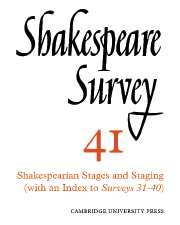Book contents
- Frontmatter
- The Shakespearian Stages, Forty Years On
- The Original Staging of The First Part of the Contention (1594)
- Charles Calvert’s Henry V
- Hamlet, An Apology for Actors, and The Sign of the Globe
- ‘Hid indeed within the centre’: The Hall/Finney Hamlet
- Malvolio and the Dark House
- The Text of Cressida and Every Ticklish Reader: Troilus and Cressida, The Greek Camp Scene
- Antony and Cleopatra, Act 4 Scene 16: ‘A Heavy Sight’
- The Tempest’s Tempest at Blackfriars
- Keats and Lucrece
- The Resources of Characterization in Othello
- Ovid and the Mature Tragedies: Metamorphosis in Othello and King Lear
- The Passing of King Lear
- Shakespeare Performances in London and Stratford-upon-Avon, 1986–7
- Professional Shakespeare Productions in the British Isles, January–December 1986
- The Year's Contributions to Shakespeare Studies: 1 Critical Studies
- 2 Shakespeare’s Life, Times, and Stage
- 3 Editions and Textual Studies
- Books Received
- Index to Volume 41
- General Index to Volumes 31-40
The Shakespearian Stages, Forty Years On
Published online by Cambridge University Press: 28 March 2007
- Frontmatter
- The Shakespearian Stages, Forty Years On
- The Original Staging of The First Part of the Contention (1594)
- Charles Calvert’s Henry V
- Hamlet, An Apology for Actors, and The Sign of the Globe
- ‘Hid indeed within the centre’: The Hall/Finney Hamlet
- Malvolio and the Dark House
- The Text of Cressida and Every Ticklish Reader: Troilus and Cressida, The Greek Camp Scene
- Antony and Cleopatra, Act 4 Scene 16: ‘A Heavy Sight’
- The Tempest’s Tempest at Blackfriars
- Keats and Lucrece
- The Resources of Characterization in Othello
- Ovid and the Mature Tragedies: Metamorphosis in Othello and King Lear
- The Passing of King Lear
- Shakespeare Performances in London and Stratford-upon-Avon, 1986–7
- Professional Shakespeare Productions in the British Isles, January–December 1986
- The Year's Contributions to Shakespeare Studies: 1 Critical Studies
- 2 Shakespeare’s Life, Times, and Stage
- 3 Editions and Textual Studies
- Books Received
- Index to Volume 41
- General Index to Volumes 31-40
Summary
The year when Allardyce Nicoll published the last survey of studies in Shakespearian playhouses and their software, 1948, was a year of abrupt demolition. Along with Nicoll’s overview in the first Shakespeare Survey came I. A. Shapiro’s study of the early Bankside engravings, which cut the foundation from John Cranford Adams’s long labour of reconstructing the Globe by showing that Cornelius Visscher’s tall octagon published in 1616 was not an accurate depiction of Shakespeare’s playhouse. Adams’s work had so dominated scholars of the theatre that its demolition might be said to have left a bombsite. This image, used by Herbert Berry for Chambers’s Elizabethan Stage volumes and their service of ‘marmorealising’ the age of document discoveries, applies more aptly to the multitude of attempts to reconstruct the physical features of the time than to the recording of its documents. Even there it is not quite an appropriate image, because lifesize reconstructions based on the Adams model still stand at the Folger Shakespeare Library, at Hofstra College, and in San Diego, Ashland (Oregon), Cleveland (Ohio), Cedar City (Utah), and Odessa (Texas), together with several more removed Fortune-imitating structures. Nonetheless it is true that some of the debris from Shapiro’s demolition is still in need of being cleared away (the shop at the Folger Shakespeare Library, that magnificent resource for book-scholarship, still sells paper cut-outs of the Cranford Adams Globe and pictures of Visscher).
- Type
- Chapter
- Information
- Shakespeare Survey , pp. 1 - 12Publisher: Cambridge University PressPrint publication year: 1989



